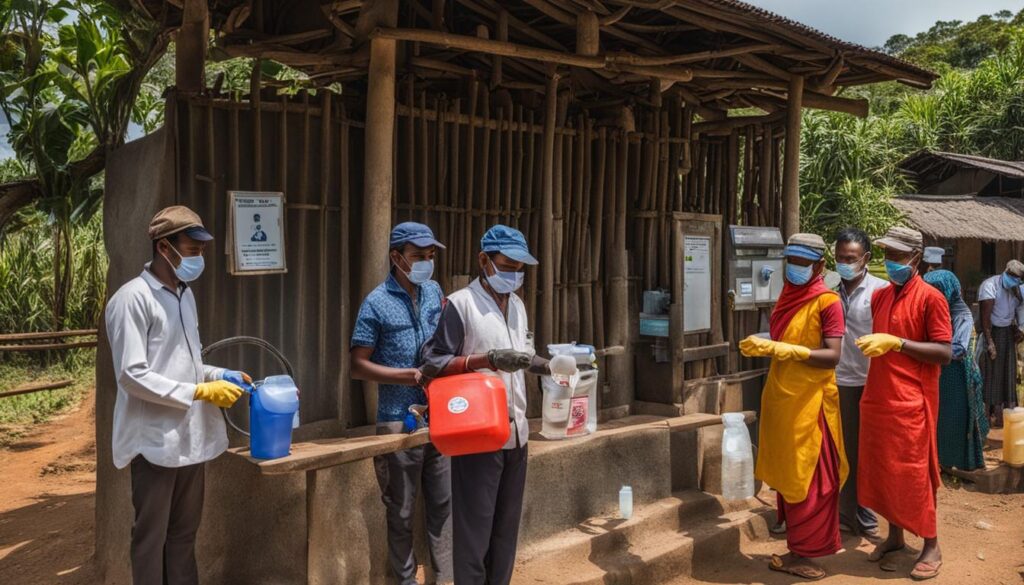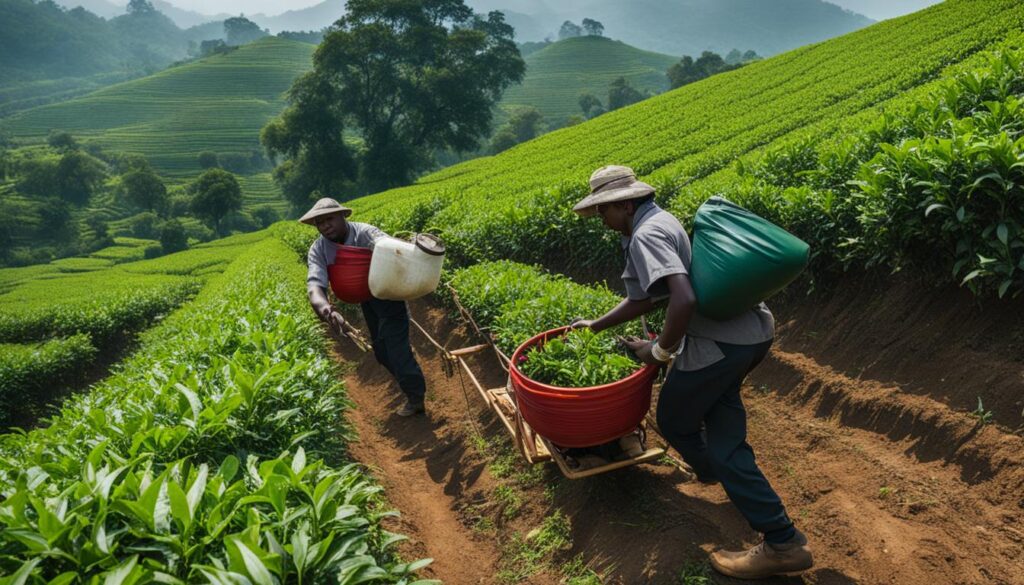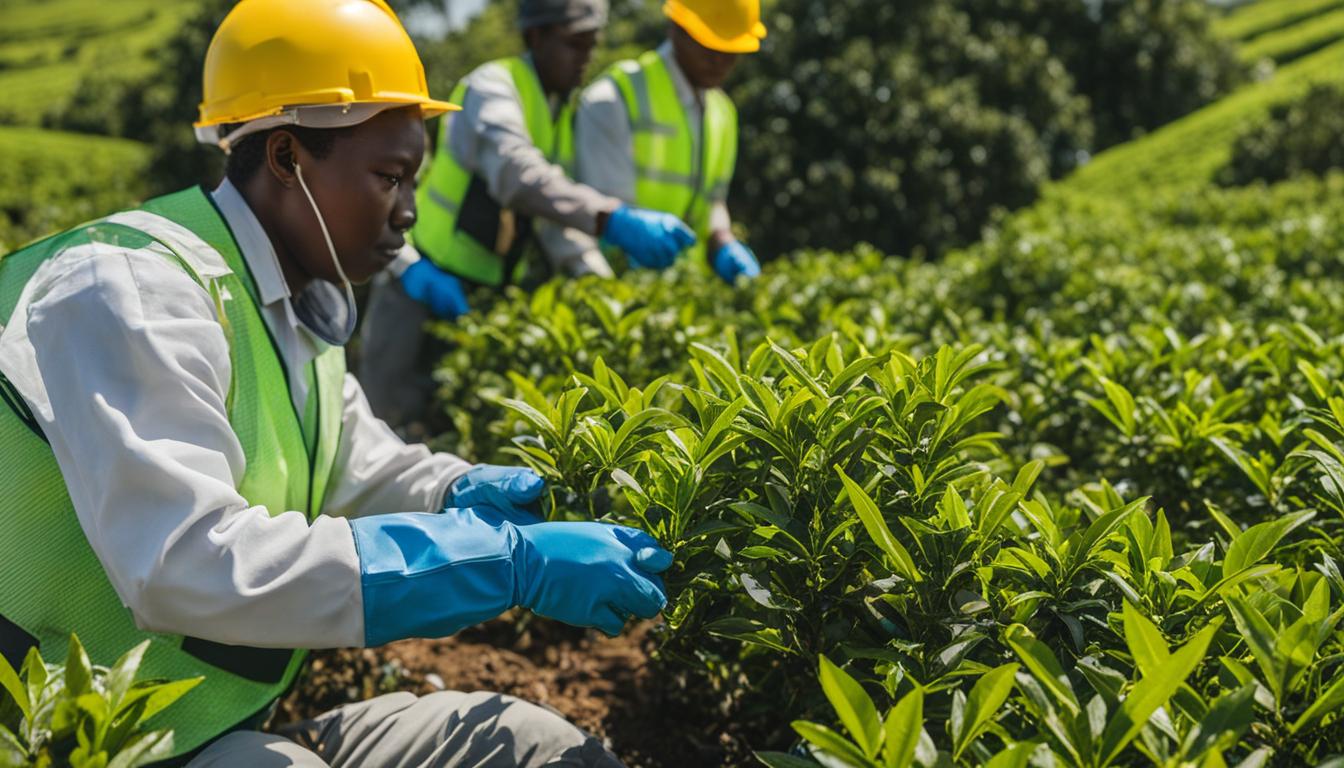Tea harvesting is a vital part of the agricultural industry, providing us with the comforting and aromatic brew that we enjoy daily. However, behind every sip of tea lies the hard work and dedication of tea farm workers who face occupational hazards that can affect their health and safety. At [Our Company Name], we understand the importance of prioritizing worker well-being in tea harvesting and the need for robust safety protocols.
Today, we will delve into the various safety measures in tea harvesting that are crucial for safeguarding the health and well-being of tea farm workers. From temperature checks to social distancing, these protocols aim to create a safe working environment and enhance productivity. So, grab a cup of your favorite tea and join us as we explore the world of tea harvesting safety protocols.
Key Takeaways
- Implementing stringent safety protocols is essential in tea harvesting to ensure the well-being of tea farm workers.
- Key safety measures include temperature checks, handwashing, social distancing, hygiene etiquette, and regular sanitization of high-touch surfaces.
- These protocols play a crucial role in preventing the spread of COVID-19 and creating a safe working environment.
- Maintaining social distancing, avoiding high-touch greetings, and minimizing face-to-face meetings are important practices in tea harvesting.
- Proper hygiene etiquette, such as respiratory etiquette and frequent sanitization, helps prevent accidents and injuries.
Entering the Premises and Hand Hygiene Practices
When it comes to tea farm safety compliance, the well-being of tea farm workers is our top priority. As they enter the premises, strict safety measures are in place to protect their health and ensure a safe working environment. Security officers, equipped with personal protective gear, conduct temperature checks to identify individuals with fever symptoms. This initial screening helps us promptly address any potential health risks and prevent the spread of contagious illnesses.
One of the key safety protocols that we enforce is proper hand hygiene. Upon entering the premises, all personnel are required to wash their hands with soap and water before proceeding. In situations where handwashing facilities may not be immediately accessible, we provide alcohol-based hand sanitizers for immediate use. To further promote hand hygiene, additional handwashing stations and sanitizing points are strategically installed across the premises for convenient access.

By implementing such hand hygiene practices, we aim to minimize the risk of disease transmission and maintain the highest standards of safety and cleanliness. Our commitment to risk management in tea harvesting includes regular training sessions for tea farm workers, ensuring that they are well-versed in safety protocols and aware of the importance of hand hygiene. These measures not only safeguard the well-being of our workers but also demonstrate our dedication to creating a safe and compliant tea farming environment.
Safe Tea Harvesting Practices: Ensuring Worker Well-being
Tea harvesting poses various occupational hazards that can jeopardize the health and safety of tea farm workers. To mitigate these risks, it is crucial to implement safe tea harvesting practices that prioritize the well-being of workers. One key aspect of these practices is maintaining social distancing to minimize the exposure to potential hazards.
Tea farm workers are instructed to maintain a distance of at least 1 meter or 3 feet from each other during activities such as queuing, lunch breaks, and collaborative work. By adhering to proper distancing guidelines, the risk of accidents and injuries can be significantly reduced. Additionally, avoiding high-touch greetings and physical contact further minimizes the spread of germs among tea farm workers.
Meetings, which are an integral part of tea farming operations, are preferably conducted through teleconferences or online platforms to limit face-to-face interactions. When face-to-face meetings are necessary, the number of attendees is kept to a minimum, and proper distancing guidelines are followed. These measures ensure the safety of tea farm workers and help prevent the transmission of diseases.
| Safe Tea Harvesting Practices | Benefits |
|---|---|
| Maintaining social distancing | Reduces the risk of exposure to potential hazards |
| Avoiding high-touch greetings and physical contact | Minimizes the spread of germs |
| Conducting meetings through teleconferences or online platforms | Limit face-to-face interactions and prevent disease transmission |
By implementing and adhering to these safe tea harvesting practices, tea farm workers can work in a secure environment and minimize the occurrence of accidents or injuries. These practices not only safeguard the well-being of workers but also contribute to the overall productivity and success of tea farming operations.
Hygiene and Safety Etiquette
In tea cultivation, maintaining proper hygiene and following safety etiquette are essential to prevent accidents and injuries. We prioritize the well-being of our tea farm workers by implementing stringent measures that promote a clean and safe working environment. By adhering to these protocols, we minimize the risk of contamination and ensure the health and safety of everyone involved.
One of the key safety practices in tea harvesting is discouraging the use of shared equipment. Our tea farm workers are encouraged to limit contact with their face, reducing the risk of contamination. Additionally, proper respiratory etiquette, such as covering coughs and sneezes with the inner side of the elbow or sleeve, is practiced to prevent the spread of respiratory illnesses.
An important aspect of hygiene and safety etiquette is maintaining clean surfaces and frequently touched areas. We conduct periodic sanitization of door handles, telephones, and other high-touch surfaces to eliminate germs and maintain a safe working environment. Self-sanitation is also carried out after contact with staircase railings, and elevator usage is curtailed to minimize potential transmission risks.
By prioritizing hygiene and safety etiquette, we aim to prevent accidents and injuries in tea cultivation. These measures, combined with the other safety protocols we have in place, contribute to a safe and secure working environment for our tea farm workers.

Hygiene and Safety Etiquette
– Discourage the use of shared equipment
– Practice proper respiratory etiquette
– Conduct periodic sanitization of frequently touched surfaces
– Carry out self-sanitation after contact with staircase railings
– Curtail elevator usage to minimize potential transmission risks
Safety Training and Compliance for Tea Farm Workers
Ensuring the safety and well-being of tea farm workers is of utmost importance in the harvesting process. Proper safety training and compliance measures play a crucial role in minimizing accidents, injuries, and the spread of diseases. At our tea farms, we prioritize the implementation of rigorous safety protocols to create a secure working environment.
One essential aspect is providing comprehensive safety training to tea farm workers. Through interactive sessions and practical demonstrations, we educate our workers on the potential hazards they may encounter and equip them with the necessary knowledge and skills to mitigate risks. By promoting safety awareness and empowering our workers, we strive to foster a culture of safety that is ingrained in every aspect of our operations.
In addition to training, we emphasize the importance of compliance with safety regulations. Our tea farm adheres to stringent safety standards and regularly conducts audits to ensure proper implementation. Compliance checks cover aspects such as personal protective equipment (PPE), machinery and equipment maintenance, and adequate safety signage. By consistently monitoring and reviewing our safety protocols, we stay proactive in identifying areas for improvement and maintaining a safe working environment for our tea farm workers.
Table: Compliance Checklist
| Aspect | Compliance Requirement |
|---|---|
| PPE | All tea farm workers must wear appropriate PPE, including gloves, masks, and safety boots. |
| Machinery and Equipment | Regular maintenance and inspections to ensure all machinery and equipment are in optimal working condition. |
| Safety Signage | Clear and visible signage to indicate potential hazards and safety precautions throughout the tea farm. |
| Emergency Response | Well-defined emergency response plans and regular drills to prepare for unforeseen situations. |
By prioritizing safety training and compliance, we demonstrate our commitment to the well-being of our tea farm workers. Through continuous improvement and a proactive approach to safety, we aim to create a work environment that is both productive and secure, allowing our tea farm workers to thrive in their roles.
Conclusion
In conclusion, the implementation of rigorous safety protocols in tea harvesting is crucial for ensuring the health and safety of tea farm workers. By following these protocols, we can create a safe working environment and reduce the risk of accidents, injuries, and the spread of diseases. Our tea farms prioritize the well-being of our workers, and we are committed to maintaining compliance with safety regulations.
To achieve this, we emphasize the importance of temperature checks, proper hand hygiene practices, social distancing, and hygiene etiquette. These measures play a significant role in safeguarding the health and well-being of our tea farm workers. We understand that safety is paramount, and we continually train our workers on safety procedures to ensure their knowledge and adherence to these protocols.
By regularly monitoring and reviewing the effectiveness of these protocols, we strive to stay updated with the latest safety practices and continuously improve our safety measures. Our goal is to provide a safe and secure working environment where our tea farm workers can thrive and contribute to the success of our tea harvesting operations. Together, we can maintain safe tea harvesting practices and prioritize tea farm worker health and safety.
FAQ
What safety protocols are implemented in tea harvesting?
The safety protocols in tea harvesting include temperature checks, handwashing, social distancing, hygiene etiquette, and regular sanitization of high-touch surfaces.
How are workers’ health and well-being protected on tea farms?
Upon entering tea farm premises, security officers conduct temperature checks to identify individuals with fever symptoms. All personnel are required to wash their hands with soap and water before entering, or use hand sanitizers when handwashing is not immediately possible. Additional handwashing stations and sanitizing points are installed across the premises.
How is social distancing maintained during tea harvesting?
Tea farm workers are instructed to maintain a distance of at least 1 meter or 3 feet apart from each other during activities such as queuing, lunch breaks, and collaborative work. High-touch greetings and physical contact are avoided, and meetings are preferably conducted through teleconferences or online platforms to minimize face-to-face interactions.
What hygiene and safety etiquette should tea farm workers follow?
Tea farm workers are encouraged to limit contact with their face, practice proper respiratory etiquette, and carry out self-sanitation after contact with high-touch surfaces. Periodic sanitization of frequently touched surfaces is conducted to maintain a clean working environment.
How are canteens and food safety managed during tea harvesting?
Tea farm workers are advised to maintain a distance of 1 meter while consuming food and are discouraged from using shared utensils and glassware. Food handlers receive training in food safety practices, and regular disinfection and sanitization are conducted to ensure a safe environment.
Why are safety protocols important in tea harvesting?
Safety protocols are crucial in preventing accidents, injuries, and the spread of diseases among tea farm workers. By implementing these measures, tea farms can create a safe working environment and enhance worker well-being.





